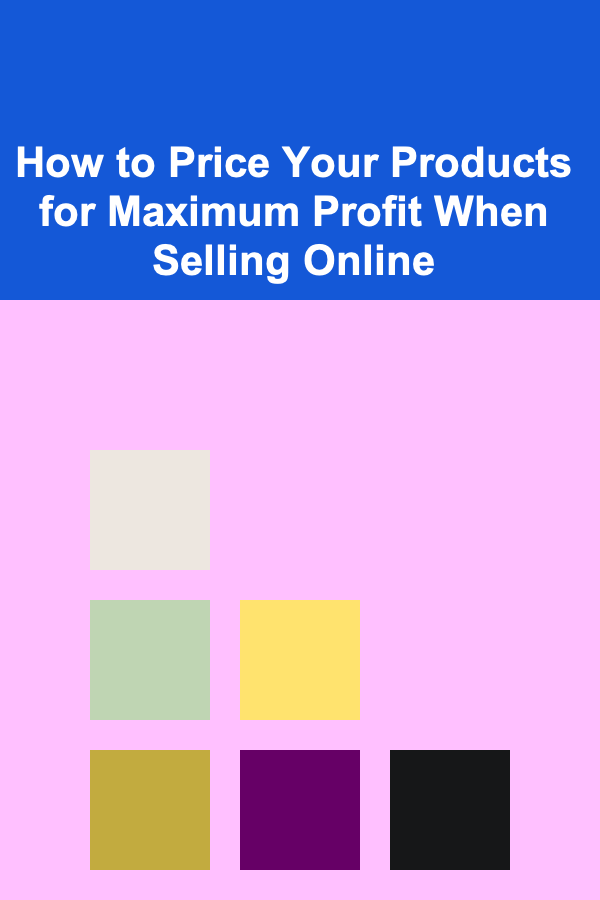
How to Price Your Products for Maximum Profit When Selling Online
ebook include PDF & Audio bundle (Micro Guide)
$12.99$9.99
Limited Time Offer! Order within the next:

Pricing your products correctly is one of the most important steps in building a successful online business. The right price can maximize your profits, attract the right customers, and even position your brand in a competitive market. However, getting the pricing right is not as simple as setting a number and hoping for the best. It requires careful analysis, strategy, and ongoing adjustments.
This actionable guide will take you through the process of pricing your products for maximum profit in an online marketplace. By the end of this article, you'll have a comprehensive understanding of the factors that affect pricing, methods to calculate the right price, and strategies for optimizing your pricing approach.
Understand Your Costs
Before setting a price, you need to understand the full range of costs involved in selling your product. This includes both direct and indirect costs, and it's crucial that you account for all of them to ensure you don't lose money or set a price that's too low for your business to be sustainable.
What to Include in Your Cost Calculation:
- Cost of Goods Sold (COGS): This is the direct cost of producing or acquiring your product. It includes raw materials, manufacturing costs, packaging, and shipping to your warehouse or distribution center.
- Marketing Costs: Advertising expenses, affiliate commissions, and other promotional costs that drive traffic to your store.
- Operating Costs: Business expenses such as website hosting, software tools, salaries, and customer support.
- Transaction Fees: Every platform you sell on (like Amazon, eBay, or Shopify) charges transaction fees, including listing fees, payment processing fees, and sometimes fulfillment fees if you're using services like Amazon FBA.
- Shipping and Handling: Both the cost of shipping products to customers and the cost of packing materials.
Actionable Steps:
- Calculate your total cost per unit by adding all the components listed above.
- Regularly reassess your costs, especially with changes in materials, labor, or shipping fees, to ensure your pricing stays aligned with your expenses.
Understand Your Target Market
Knowing your audience is key to pricing your product correctly. If you're selling online, your market could be global, local, or somewhere in between. Understanding the price sensitivity of your customers, their buying behavior, and their willingness to pay will directly influence your pricing strategy.
What to Consider:
- Demographic Factors: Age, income level, education, and geographic location all influence how much customers are willing to spend.
- Psychographic Factors: Lifestyle, preferences, and values can impact how your customers perceive value and quality.
- Competitor Analysis: Identify your key competitors and analyze their pricing strategies. Are they offering similar products at a higher or lower price? This gives you context and helps you find your niche.
Actionable Steps:
- Conduct surveys or customer interviews to understand what they value in your products and what they're willing to pay for certain features or quality.
- Use analytics tools to monitor customer behavior on your website and see where they drop off during the purchase process. High abandonment rates might indicate price sensitivity.
Choose Your Pricing Strategy
There are various pricing strategies to consider, each offering a different approach to maximizing profits. The strategy you choose should be based on your market, brand positioning, and customer perception.
Popular Pricing Strategies:
- Cost-Plus Pricing: This is the most basic method, where you calculate the cost of production and add a markup to ensure a profit margin. For example, if your cost of production is $20 and you want to mark it up by 50%, your price would be $30.
- Competitive Pricing: Research your competitors' pricing and set your price within the same range. This strategy works well in highly competitive markets.
- Value-Based Pricing: This strategy sets prices based on the perceived value to the customer, rather than just the cost of production. If your product has unique features or benefits that resonate with customers, you can price it higher.
- Penetration Pricing: This strategy involves setting a low price initially to attract customers and gain market share. Over time, you can gradually increase prices as your brand becomes established.
- Price Skimming: This is used for new, innovative, or luxury products. You start with a high price to target early adopters who are willing to pay a premium, then lower the price over time to capture more price-sensitive customers.
Actionable Steps:
- Review your goals to decide on a pricing strategy: Are you looking to maximize profit immediately, or build long-term market share?
- Choose the strategy that aligns with your product's unique selling proposition (USP) and market positioning.
Factor in Perceived Value and Brand Positioning
A higher price doesn't always mean a better product in the eyes of consumers, but it can signal quality, exclusivity, and luxury. Your product's perceived value is closely tied to your brand's identity, and how you position your product in the market can significantly impact your pricing power.
What to Consider:
- Brand Perception: How do you want customers to perceive your brand? If you're positioning yourself as a luxury brand, pricing your products high reinforces that perception.
- Packaging and Design: The way your product is packaged can influence perceived value. Premium packaging and thoughtful design often justify a higher price.
- Customer Experience: If you offer exceptional customer service, a smooth purchasing experience, and fast delivery, customers may be willing to pay more for the convenience and service you provide.
Actionable Steps:
- Invest in branding and marketing that clearly communicates the value your product offers.
- Use premium packaging or offer special editions of your product at a higher price to enhance perceived value.
Test and Adjust Your Pricing
Pricing isn't a one-time decision---it requires continuous testing and optimization. As your business grows, market conditions change, and customer preferences evolve, your pricing strategy should evolve as well.
What to Do:
- A/B Testing: Test different prices to see how customers respond. You can run A/B tests on product pages to see if a higher price increases conversions or if a discount leads to more sales.
- Dynamic Pricing: Consider implementing dynamic pricing where your product prices adjust based on demand, competitor prices, or time of day. This is particularly effective in industries like travel, e-commerce, and ticketing.
- Promotions and Discounts: Regularly offer promotions, sales, or discounts to boost sales, but ensure that you're not devaluing your product or your brand. Use time-limited offers to create urgency without eroding your pricing power.
Actionable Steps:
- Implement A/B tests to refine your pricing model and find the optimal price point.
- Use analytics to track how changes in pricing affect sales volume, profit margins, and customer loyalty.
Monitor and Analyze Market Trends
The market is always evolving, and your pricing strategy should reflect this. Keep an eye on industry trends, shifts in consumer behavior, and competitor moves. For example, if a competitor lowers their price, you may need to evaluate whether you should adjust your pricing to maintain competitiveness.
Key Market Trends to Watch:
- Seasonality: Some products sell better during certain seasons. Adjust your pricing accordingly to capitalize on demand spikes during holidays or events.
- Economic Factors: Inflation, supply chain issues, and changes in consumer spending habits can all affect your pricing.
- Consumer Behavior: Stay updated on changing preferences and attitudes toward spending. If consumers become more price-conscious, you might need to adjust your pricing or offer more value.
Actionable Steps:
- Subscribe to industry reports, competitor newsletters, and market research to stay informed on changes in your industry.
- Regularly assess how external factors are influencing your pricing and adjust accordingly.
Conclusion
Pricing your products for maximum profit when selling online is both an art and a science. It requires a deep understanding of your costs, target market, and competitors, combined with a thoughtful pricing strategy that reflects your brand's positioning. However, the process doesn't stop once you've set your prices. Ongoing testing, market research, and adjustments are essential to ensure that you stay competitive and profitable in a constantly evolving marketplace.
By following the steps outlined in this guide, you'll be well on your way to pricing your products effectively, ensuring that you maximize profit while delivering value to your customers.
Reading More From Our Other Websites
- [Home Holiday Decoration 101] How to Use Indoor Holiday Lighting to Create a Warm, Cozy Atmosphere
- [Home Party Planning 101] How to Make Your Home Party Fun and Memorable for Kids
- [Home Cleaning 101] How to Tackle a Messy Playroom
- [Home Security 101] How to Protect Your Home's Wi-Fi Network from Hackers
- [Organization Tip 101] How to Incorporate Mirrors to Enhance Your Fitness Area
- [Home Cleaning 101] How to Clean a Toaster Oven for Baking Perfection: A Step-by-Step Guide
- [Polymer Clay Modeling Tip 101] How to Turn Polymer Clay Miniatures into 3D‑Printed Molds for Mass Production
- [Organization Tip 101] How to Create a Chore Chart for Room Maintenance
- [Home Lighting 101] How to Choose the Best Light Fixtures for Your Home Decor
- [Personal Investment 101] The Top 10 Passive Income Ideas Using Deep Learning

How to Protect Your Brand Reputation on Social Media
Read More
How to Renovate Your Rental Property Without Major Costs
Read More
How to Start Freelancing and Make Extra Money from Home
Read More
How to Use a Checklist for Sustainable Garden Maintenance
Read More
How to Use Workflow Automation to Improve Team Collaboration
Read More
How To Give and Receive Feedback Remotely
Read MoreOther Products

How to Protect Your Brand Reputation on Social Media
Read More
How to Renovate Your Rental Property Without Major Costs
Read More
How to Start Freelancing and Make Extra Money from Home
Read More
How to Use a Checklist for Sustainable Garden Maintenance
Read More
How to Use Workflow Automation to Improve Team Collaboration
Read More